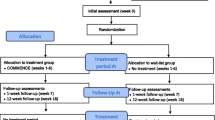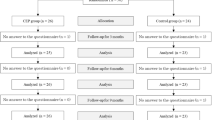Abstract
A low rate of compliance for exercise regimens is a difficult problem for programs aimed at treating or preventing musculoskeletal pain. In fact, the utility of exercise for common pain problems has been debated since poor compliance confounds proper program evaluation. Thus, the purpose of the present study was to evaluate the effects of a compliance enhancement measure and subsequently to assess the effects of physical activity on pain perception. Forty-eight employees (mean age=42, 20 females) currently working at two companies and who reported musculoskeletal pain, but noexercise habit voluntarily served as subjects. The Comparison Group was provided with information and free membership at a health center. The Exercise Compliance Enhancement Group met individually with a behavioral psychologist, who employed cognitive-behavioral techniques, to plan their activity program. Results showed that the Compliance Enhancement Group had a higher rate of adherence and participated in significantly more exercises over the course of 6 months than did the Comparison Group. However, analyses based on pre- and posttest gain scores showed that the differences between the groups for aerobic capacity and pain intensity were not significant. However, when compilers were compared with noncompliers, those complying with the activity program were found to have improved their aerobic capacity more than noncompliers. Yet for overall pain intensity ratings, the difference between compilers and noncompliers was still not significant. Intensity ratings made immediately before and after exercising indicated that exercise activities were related to a significant increase in pain intensity. These results indicate that compliance for exercise may be significantly improved, but the effect of exercise activities on overall pain intensity was not significant relative to the comparison group.
Similar content being viewed by others
References
Nachemson AL. Exercise, fitness, and back pain. In: Bouchard C, Shephard RJ, Stephens T, Sutton JR, McPherson BD, eds.Exercise, fitness, and health: A consensus of current knowledge. Champaign, IL: Human Kinetics Books, 1990.
Biddle S, Mutrie N.Psychology of physical activity and exercise: A health-related perspective. London: Springer-Verlag, 1991.
Dubbert PM. Exercise in behavioral medicine.J Consult Clin Psychol 1992; 60: 613–618.
Faas A, Chavannes AW, van Eijk JTM, Gubbels JW. A randomized, placebo-controlled trial of exercise therapy in patients with acute low back pain.Spine 1993; 18: 1388–1395.
Gundewall B, Liljeqvist M, Hansson T. Primary prevention of back symptoms and absence from work.Spine 1993; 18: 587–594.
Rodriquez AA, Bilkey WJ, Agre JC. Therapeutic exercise in chronic neck and back pain.Arch Phys Med Rehab 1992; 73: 870–875.
Flor H, Fydrick T, Turk DC. Efficacy of multidisciplinary pain treatment centers: A meta-analytic review.Pain 1992; 49: 221–230.
Bouchard C, Shepard RJ, Stephens T, Sutton JR, McPherson BD, eds.Exercise, fitness, and health: A consensus of current knowledge. Champaign, IL: Human Kinetics Books, 1990.
Cataldo MF, Coates TJ, eds.Health and industry: A behavioral medicine perspective. New York: John Wiley & Sons, 1986.
Shepard RJ. Current perspectives on the economics of fitness and sport with particular reference to worksite programs.Sports Med 1989; 7: 286–309.
Brannon L, Feist J.Health psychology: An introduction to behavior and health. Belmont, CA: Wadsworth Publishing Co., 1992.
Dishman RK. Compliance/adherence in health-related exercise.Health Psychol 1982; 1: 237–267.
Martin JE, Dubbert PM. Adherence to exercise. In: Terjung RL, ed.Exercise and sport sciences reviews (Vol. 13). New York: Macmillan, 1985.
Turk DC, Rudy TE. Neglected topics in the treatment of chronic pain patients: Relapse, noncompliance, and adherence enhancement.Pain 1991; 44: 5–28.
Bigos SJ, Battié MC. Risk factors for industrial back problems.Semin Spine Surg 1992; 4: 2–11.
Jensen MP, Karoly P. Pain-specific beliefs, perceived symptom severity and adjustment to chronic pain.Clin J Pain 1992; 8: 123–130.
Vlaeyen JWS, Kole-Snijders AMJ, Boeren RGB, van Eek H. Fear of movement/(re)injury in chronic low back pain and its relation to behavioral performance.Pain 1995; 62: 363–372.
Waddell G, Newton M, Henderson I, Somerville D, Main CJ. A Fear-Avoidance Beliefs Questionnaire and the role of fear-avoidance beliefs in chronic low back pain and disability.Pain 1993; 52: 157–168.
VonKorff M. Perspectives on management of back pain in primary care. In: Gebhart GF, Hammond DL, Jensen TS, eds.Proceedings of the 7th World Congress on Pain: Progress in pain research and management (Vol. 2). Seattle: IASP Press, 1994, pp. 97–110.
Åstrand PO, Rodahl K.Textbook of work physiology. New York: McGraw-Hill, 1970.
Wilson PH, ed.Principles and practice of relapse prevention. New York: Guilford Press, 1992.
Johnson L, Sheridan DP. Exercise. In: Sheridan DP, Winogrond IJ, eds.The preventive approach to patient care. Amsterdam: Elsevier Science Publishing Co., 1987.
Gebhardt WA. Effectiveness of training to prevent job-related back pain: A meta-analysis.Br J Clin Psychol 1994; 33: 571–574.
Lahad A, Malter AD, Berg AO, Deyo RA. The effectiveness of four interventions for the prevention of low back pain.JAMA 1994; 272: 1286–1291.
Carosella AM, Lackner JM, Feuerstein M. Factors associated with early discharge from a multidisciplinary work rehabilitation program for chronic low back pain.Pain 1994; 57: 69–76.
Author information
Authors and Affiliations
Rights and permissions
About this article
Cite this article
Linton, S.J., Hellsing, AL. & Bergström, G. Exercise for workers with musculoskeletal pain: Does enhancing compliance decrease pain?. J Occup Rehab 6, 177–190 (1996). https://doi.org/10.1007/BF02110754
Issue Date:
DOI: https://doi.org/10.1007/BF02110754




